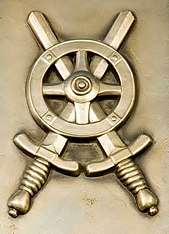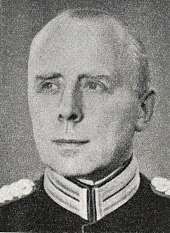Swedish Army Service Troops

Swedish Army Service Troops (Swedish: Trängtrupperna or Underhållstrupperna, before 1942 called Trängen) is the train branch of the Swedish Army. The task of the troops is to train personnel for maintenance units, provide supplies, repair damaged equipment, retract and care for sick personnel as well as in the event of war mobilizing them. The troops are today fully motorized.
History
In 1885, the first army service unit was established, the Train Battalion (Trängbataljonen) in Marieberg, Stockholm. It was divided into the Svea Train Battalion (Svea trängbataljon, T 1) and the Göta Train Battalion (T 2) in 1891, the latter being placed in Karlsborg. According to the Defence Act of 1892, two new train battalions, Norrland Train Battalion (Norrlands trängbataljon, T 3) in Sollefteå and Wendes Train Battalion (Wendes trängbataljon, T 4) in Landskrona were established. Through the Defence Act of 1901, two further train units (now called corps) were established, so that there would be one train unit for each army division.[1] These were the Second Svea Train Corps (Andra Svea trängkår, T 5) and Second Göta Train Corps (Andra Göta trängkår, T 6), which were placed in Sala (1906), and in Linköping (1911) respectively. They changed names in 1904 to Västmanland Train Corps (Västmanlands trängkår, T 5), and Östgöta Train Corps (Östgöta trängkår, T 6). Meanwhile, Wendes Train Corps (Wendes trängkår) changed name to Scanian Train Corps (Skånska trängkåren). In 1905, Göta Train Corps moved to Skövde and in 1907 Svea Train Corps moved to Örebro and Scanian Train Corps moved to Hässleholm.[1]
In the Defence Act of 1914, an inspector (colonel) became the highest guardian of the army service corps. By now it occupied 87 officers plus 6 regimental physicians and 6 battalion physicians, 6 battalion veterinarians and regimental pastors.[2] According to the Defence Act of 1925, Västmanland and Östgöta Train Corps were disbanded, while Svea Train Corps was placed in Linköping. In the Defence Act of 1942, the army service troop were significantly expanded and an independent train company was established in Nora (T 2 N), disbanded in 1952. After the independent commissariat and ordnance companies were transferred to the army service troops, the corps became regiments (1949). In 1954 there were Svea Train Regiment (Svea trängregemente, T 1) in Linköping, Göta Train Regiment (T 2) in Skövde, Norrland Train Regiment (Norrlands trängregemente, T 3) in Sollefteå and Scanian Train Regiment (Skånska trängregementet, T 4) in Hässleholm.[1] Officers where trained at the Swedish Army Service Troops Cadet School (Trängtruppernas kadettskola, TrängKS) 1942–1961, the Swedish Army Service Troops Cadet and Officer Candidate School (Trängtruppernas kadett- och aspirantskola, TrängKAS) 1961–1981, the Swedish Army Service Troops Officers College (Trängtruppernas officershögskola, TrängOHS) 1981–1991 and the Swedish Army Maintenance Center (Arméns underhållscentrum, UhC) 1991–1997.
Inspector of the Swedish Army Service Troops

The head was called Inspector of the Swedish Army Service Troops (Tränginspektören).[3] The Inspector was from 1991 to 1997 the head of the Swedish Army Maintenance Center (Arméns underhållscentrum, UhC).
- 1903–1906 – Carl Wilhelm Ericson
- 1906–1916 – ?
- 1916–1926 – John Améen
- 1927–1931 – Eric Virgin
- 1931–1933 – Olof Thörnell
- 1933–1942 – Axel Bredberg
- 1942–1946 – Ivar Gewert
- 1946–1949 – Gottfrid Björck
- 1949–1956 – Knut Hagberg
- 1956–1960 – Adolf Norberg
- 1960–1965 – Birger Hasselrot
- 1965–1972 – Magnus Bruzelius
- 1972–1974 – Dag Nordenskiöld
- 1974–1983 – Börje Wallberg
- 1983–1987 – Curt Sjöö
- 1987–1991 – ?
- 1991–1993 – Ragnar Söderberg
- 1993–1997 – Lars Nordmark
See also
References
- 1 2 3 Carlquist, Gunnar; Carlsson, Josef, eds. (1955). Svensk uppslagsbok (2nd, revis. and enlarged ed.). Malmö: Förlagshuset Norden. pp. 1096–1097. LIBRIS 11112. Archived from the original on 2014-03-12.
- ↑ Westrin, Theodor, ed. (1920). Nordisk familjebok: konversationslexikon och realencyklopedi (in Swedish). 30 (Ny, rev. och rikt ill. ed.). Stockholm: Nordisk familjeboks förl. p. 180. LIBRIS 8072220.
- ↑ Gullberg, Ingvar E. (1977). Svensk-engelsk fackordbok för näringsliv, förvaltning, undervisning och forskning [A Swedish-English dictionary of technical terms used in business, industry, administration, education and research] (in Swedish) (2nd ed.). Stockholm: Norstedt. p. 1040. ISBN 91-1-775052-0. LIBRIS 8345587.